|
|
|
Sort Order |
|
|
|
Items / Page
|
|
|
|
|
|
|
| Srl | Item |
| 1 |
ID:
109457
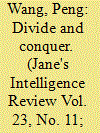

|
|
|
| 2 |
ID:
130840
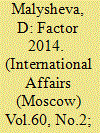

|
|
|
|
|
| Publication |
2014.
|
| Summary/Abstract |
The article examines the impact of the withdrawal of most U.S. and International Security Assistance Force (ISAF) armed forces from Afghanistan in 2014 on foreign relations in Central Asia. The possibility that the withdrawl will lead to a return to power of the Taliban movement and impact of that outcome on internal security in Tajikistan, Uzbekistan and Turkmenistan are examined. Russia's foreign relations with Central Asia are discussed in relationship to possible instability in Afghanistan.
|
|
|
|
|
|
|
|
|
|
|
|
|
|
|
|
| 3 |
ID:
132869
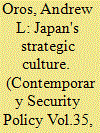

|
|
|
|
|
| Publication |
2014.
|
| Summary/Abstract |
Japan has shown three distinct strategic cultures since its emergence as a modern state in the 19th century: isolationist and non-military, militarist, and post-World War II strategic culture characterized by great reluctance to use military power abroad, even in collective self-defence. This article examines Japan's strategic culture and the potential for a fourth distinct strategic culture through the broader framework of security identity, arguing that this is evolving but has not changed as much as one might expect due to institutionalized antimilitarism and political support for the security practices it has engendered. Contemporary Japanese strategic culture can be understood through debates over recent Japanese security policy as well as actual changes in security practice. Domestic politics and a changing international environment are likely to lead Japan to a somewhat more active military role in the near term, but an analysis based on the dynamics of Japan's dominant security identity suggests that its strategic culture will continue to show a reluctance to use or develop military power beyond very limited scenarios, despite vocal efforts by some political actors to increase military activity abroad.
|
|
|
|
|
|
|
|
|
|
|
|
|
|
|
|
| 4 |
ID:
132047
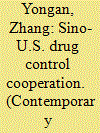

|
|
|
|
|
| Publication |
2014.
|
| Summary/Abstract |
Asia's Golden Triangle and Golden Crescent are two of the world's largest drug-producing areas. They make about 90% of the world's opium-Afghanistan alone accounts for about 74% 0.012).' lllicit drugs
production and tra?ieking in Asia pose a serious threat to China and the U.S.. In recent years, China and the U.S. have been working closer to deal with this threat. Their cooperation, however, has not always been smooth. The Threats as drug production in Asia rises steadily, the number of types of drugs increases, and with globalization and a growing consumer society, international drug trafficking routes targeting China and U.S. markets have become more complicated. The threats to both countries have also grown. First, although opium poppy cultivation in the Golden Triangle has been declining in recent years, it still poses a threat in the 1ong-tcrm because of its large base. According to a report issued by United Nations Office on Drugs and Crime (UNODC), in 2011 poppy plantations covered 51,000
|
|
|
|
|
|
|
|
|
|
|
|
|
|
|
|
| 5 |
ID:
133284
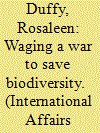

|
|
|
|
|
| Publication |
2014.
|
| Summary/Abstract |
This article examines the rise in militarized approaches towards conservation, as part of a new 'war for biodiversity'. This is a defining moment in the international politics of conservation and needs further examination. The claims that rhinos and elephants are under threat from highly organized criminal gangs of poachers shapes and determines conservation practice on the ground. Indeed, a central focus of the 2014 London Declaration on the Illegal Wildlife Trade is the strengthening of law enforcement, and recent policy statements by the US government and the Clinton Global Initiative also draw the link between poaching, global security and the need for greater levels of enforcement. Such statements and initiatives contribute substantially to the growing sense of a war for biodiversity. This article offers a critique of that argument, essentially by asking how we define poachers, and if militarized approaches mean conservationists are becoming more willing to engage in coercive, repressive policies that are ultimately counterproductive. Further, this article examines how the new war for biodiversity is justified and promoted by referring to wider debates about intervention in a post-Cold War era; notably that the international community has a responsibility towards wildlife, especially endangered species, and that military forms of intervention may be required to save them.
|
|
|
|
|
|
|
|
|
|
|
|
|
|
|
|
| 6 |
ID:
132875
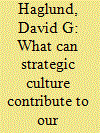

|
|
|
|
|
| Publication |
2014.
|
| Summary/Abstract |
This article reflects on application of the concept of strategic culture to supply analytical and policy-relevant guidance to those who ponder the future of security relations in the Asia-Pacific. Argued here is that, notwithstanding some obvious problems with the concept, there is utility in the application of strategic culture to the analysis of regional security challenges. To claim that strategic culture may not be equally applicable to all states in the Asia-Pacific region is not the same as saying it has no applicability at all, especially if the states to which it is applicable are important regional actors. This article suggests that both an old approach derivative of national character, and a new one associated with path dependence, might together prove fruitful for policy analysts and policy-makers alike, as they wrestle with what many assume to be the fundamental question of the coming half-century in the Asia-Pacific, namely whether a great power war in the region can be averted. Although there is much variation in the manner with which authors apply the master concept of strategic culture to their specific Asia-Pacific cases, each takes seriously the utility of a cultural approach to national strategic choice. So while the quest for reliable causality and predictive capability on a region-wide basis may remain that of the will-o'-the-wisp, there can be no gainsaying that, on a case-by-case basis, the authors show that the approach can demonstrate valuable insights into the policy dilemmas of cultural provenance and content confronting the Asia-Pacific.
|
|
|
|
|
|
|
|
|
|
|
|
|
|
|
|
| 7 |
ID:
156659


|
|
|
|
|
| Summary/Abstract |
Do considerations that cause military spending increases symmetrically cause spending cuts? Models of military spending that estimate a single effect for major independent variables implicitly assume that this is the case. In reality, the mechanisms that cause military spending increases do not always imply symmetrical cuts, and vice versa. This article examines two considerations widely held to influence military spending: economic growth and international threats. In both cases, there are reasons to suspect asymmetric effects on military spending. While recessions always create pressure for cuts in military spending, which frequently constitutes a substantial share of national budgets, economic growth does not necessarily imply a symmetric need for spending increases. Similarly, while national security policymakers, including the military, are likely to call for spending increases when international threats worsen, they have self-interested reasons to minimize the budgetary implications of declining threats. A cross-national analysis of military spending since World War II shows that economic decline has a larger impact on military spending than economic growth. In regards to international threat, the findings are more complex. There is no evidence that international threat is related to changes in military spending in the short run, and little evidence of a long-run relationship. The threat variables appear to account for cross-sectional variation in military spending but not variation within each state over time. These results suggest military budgets require more time to recover from economic decline than benefit from economic growth as recessions can thus produce long deviations from the equilibrium relationship between the size of the economy and the military budget. This finding in military spending suggests consequences for our understanding of balance of power and power transitions.
|
|
|
|
|
|
|
|
|
|
|
|
|
|
|
|
|
|
|
|
|